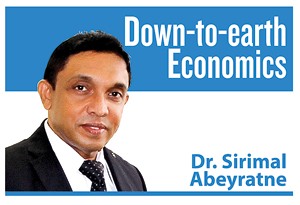Desire and fear
View(s):
Lunch is delivered at a December 3 conference centre in central London where talks continue on a trade deal between the EU and the UK. (Photo - AFP)
For UK customers, Japanese motorcars are cheaper than similar German models because of the differences in cost of production. I am using this example to get my point across. For instance, imagine that a Japanese car costs £10,000, while a German car costs £11,000. The UK also produces its own motorcar which has a higher production cost – £12,000. If all three motorcars are similar models, then obviously the Japanese car becomes the most demanded by the UK customers.
If the UK has a £2,000 import duty on cars imported from Japan and Germany, then the Japanese car will cost £12,000 and the German car, £13,000. The UK’s own model also becomes price-competitive with the Japanese model as both are sold at the same price. The customers will have to pay additional £2,000, while the “cost-inefficient” local manufacturer will also survive in the market. As cars become more expensive to the UK customers now, however, the demand will be less, and the car market will be smaller.
After the UK becomes a member of the European Union (EU), there is free trade among the EU members, including the UK and Germany. Accordingly, German cars which now enter the UK market duty-free will cost only £11,000. Japanese cars are still sold at import duty inclusive price of £12,000, because Japan is not a member of the EU. The costly German cars now become cheaper than both the Japanese cars and the UK’s own products. The demand will “divert” from Japanese cars to German makes. The demand for UK’s own motorcar will also shrink against growing demand for German cars. Germany can “create” trade by producing more cars and selling in the UK market.
25 years of trade
During the past 25 years, trade liberalization in the world got accelerated, while average tariffs have also declined from 10.5 per cent to 6.4 per cent, according to the World Trade Organisation (WTO). World GDP has almost trebled, and world exports quadrupled; developing countries have performed faster than advanced countries, increasing their GDP and exports six-fold. During this period, more than one billion people in the world have been lifted from poverty too because the figure 31 per cent of people who were poor and estimated to earn less than $1.90 a day, declined to 9 per cent. And this decline in poverty took place along with world population growth – over 2 billion more people were born and added to world population during this 25-year period.
The period was important for some other interesting development related to international trade, which is my story today – trade agreements. By 1990, the world had 28 notified trade agreements out of which 22 were active. After 30 years, today the world has 496 notified trade agreements, out of which 305 are active. If we take stock of all the trade agreements both active and inactive, which have been notified to the WTO, there are more than 700. In fact, all 164 member countries of the WTO are also members of one or more trade agreements in the world.
Well; Sri Lanka has always been a forerunner in world economic affairs and, the country was a member of one the world’s oldest trade agreements – Asia Pacific Trade Agreement (APTA) which was signed in 1975. At that time, the world had only nine trade agreements in force.
Second best
Isn’t it interesting to see that, while having trade liberalisation packages at hand, why on earth has such a big enthusiasm driven an exponential growth of trade agreements? Perhaps, it looks like an irrational move because everybody is moving towards “free trade”, but they all are interested in creating “free trade pacts” with one another!
The main reason is “desire and fear”. We all know that free trade is beneficial, but it has a cost too. We also know that benefits outweigh the costs at the end of the day so that the net outcome of free trade is good. But the problem is that the benefit is long-term, and the cost is short-term. Given this issue, there are many countries in the world which are afraid of bearing the short-term costs for long-term benefits. This question is apparently more political than economic. Therefore, they tend to think that if they cannot have free trade with the entire world, then they should have free trade at least with somebody in the form of bilateral or multilateral trade agreement.
In that sense, trade agreements are viewed as a “second best” option, when the “first best” option – free trade in the world, is more challenging and more fearful. This notion is, anyway, not necessarily true, because it is subject to some other conditions as we need to explore below. Some may also believe that trade agreements are a step towards free trade. This notion is based on the idea that when we cannot have free trade with the entire world, then first we will start having it with a part of the world. This notion also needs qualification as we find out below.
Trade creation and diversion
One way of making an assessment about whether a trade agreement is good or bad for the participating countries is to look into its “trade creation” effects and “trade diversion” effects. In our opening story, both the UK and Germany are motorcar manufacturers, while between the two countries the UK is the high-cost producer. After joining the EU, the more efficient producer – Germany, can produce more and sell at lower cost. The consumers in the UK will benefit.
Trade is, however, not a one-way flow, nor a one-commodity trade; out of millions of commodities, the UK will also be more efficient in some of the products. It will also produce more of them and sell, but not necessarily the motorcars, as described in our example. As a result of a trade agreement, the more efficient producers can expand production and trade, irrespective of their location and their markets.
 While trade creation is a benefit of trade agreements, they can bring out losses too in terms of trade diversion. In our example, actually, Germany is not the most efficient producer, but Japan which had a better market share under free-trade conditions. Even after the UK imposed a uniform import duty on both Japanese and German motorcars, the Japanese car was still able to compete in the UK market because of its cost efficiency. However, the UK’s decision to join the EU diverted trade from the low-cost Japanese manufacturer to the high-cost German manufacturer. In effect, the UK consumers lost their opportunity to buy from the more efficient suppliers, just because they are out of the pact.
While trade creation is a benefit of trade agreements, they can bring out losses too in terms of trade diversion. In our example, actually, Germany is not the most efficient producer, but Japan which had a better market share under free-trade conditions. Even after the UK imposed a uniform import duty on both Japanese and German motorcars, the Japanese car was still able to compete in the UK market because of its cost efficiency. However, the UK’s decision to join the EU diverted trade from the low-cost Japanese manufacturer to the high-cost German manufacturer. In effect, the UK consumers lost their opportunity to buy from the more efficient suppliers, just because they are out of the pact.
EU trade
Because millions of goods and services are produced and traded in the world, a trade agreement will have both creation effects and trade diversion effects. Thus, whether the trade agreement has brought about benefits or losses depends on whether its trade creation effects are larger or smaller than its trade diversion effects. Therefore, there is actually a “fifty-fifty” chance for getting benefits or losses out of a trade agreement. Getting either benefits or losses from a trade agreement is conditional too.
Having more countries in an agreement reduces the chances for losses, while having high protection against rest of the world increases the chances for losses. In that sense, the EU is more than a free trade area with 27 member countries. And the EU is also not a trade protected region for the rest of the world as well. The EU countries exports less than 40 per cent to the rest of the world, as their exports among themselves is more than 60 per cent, and that is “free trade”.
By the way, the UK has already left the EU and, scheduled to cut off all its EU privileges by December 31, 2020. We must then return to this issue again.
(The writer is a Professor of Economics at the University of Colombo and can be reached at sirimal@econ.cmb.ac.lk and follow on Twitter @SirimalAshoka).


